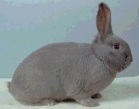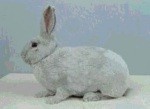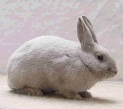

Lilac rabbits originated in a number of places around the same time.
The first known breeder was H. Onslow of Cambridge, England. In 1913 he showed Lilacs for the first time at the famous London exhibition.
In 1913, Mabel Illingworth crossed the Blue Imperial (a breed that she had newly developed) with the Havana and created a Lilac rabbit, which she called the Essex Lavender.
In 1922, Professor R.C. Punnet of Cambridge University crossed the Blue Beveren and the Havana to create a lilac rabbit, which he called the Cambridge Blue.
Eventually the 3 British lilac strains merged together and were recognized by the British Rabbit Council as the Lilac rabbit.
Another story of the history of the Lilac rabbit states that the breed first showed up in a litter of Havana rabbits as a sport.
Lilacs were being developed in countries other than England as well.
In 1917, C.H. Spruty of Gouda, Holland, used Havanas and Blue Beverens to create a lilac rabbit which he called the Gouwenaar or Gouda. Gouwenaars are recognized today in Holland and the Scandinavian countries.
In America from 1922 to 1926 many shipments were being made from England to the United States and the breed was becoming quite popular. In the 1930's the Lilac was recognized by the ARBA and a National Lilac Club was formed. In 1951 the Lilac club became inactive and the Lilac began to loose most of its breeders but in the next year a few Lilac breeders reorganized the club and made it active again. Today, even though Lilacs have such lovely fur and sweet temperaments, they are still a very uncommon breed.
Lilacs are recognized in the US by the American Rabbit Breeders Association, and in the UK by the British Rabbit Council. Other lilac type rabbits such as the Gouwenaar or Gouda are recognized in Norway, Denmark, Finland, and the Netherlands. The Perle De Halle (or also called the Halle Perle Gray), a breed that is similar to the Lilac, is recognized in Belgium. Another breed, the Marburger, which is darker and more bluish than the Lilac, is recognized in Germany, the Netherlands, Denmark, Norway, and Finland.
 |
 |
 |
